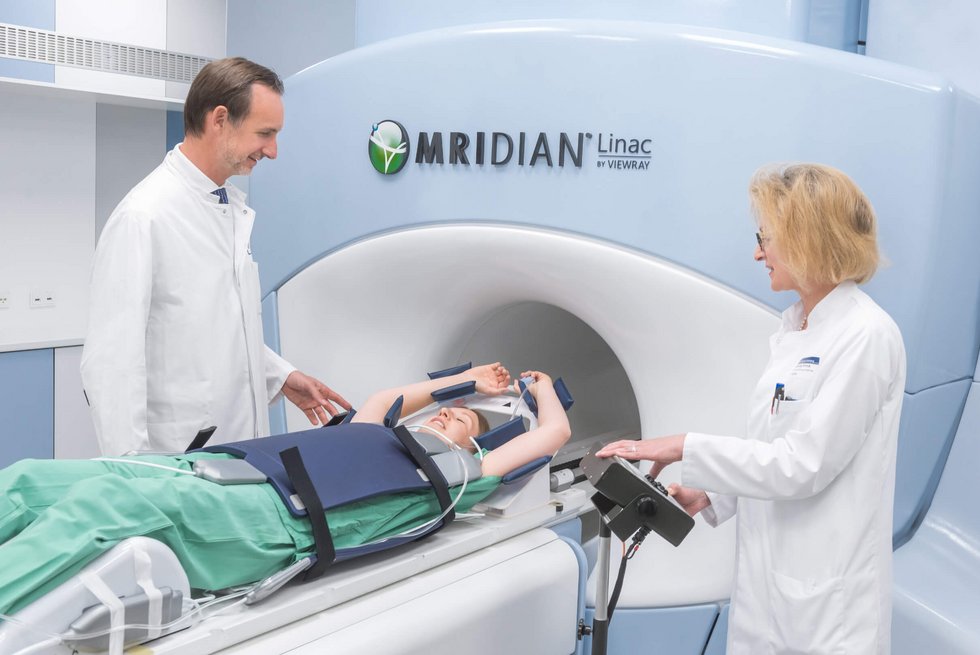
Radiation therapy is the second most successful form of cancer treatment after surgery and is used for more than 50 percent of all patients. In recent years, the effectiveness and chances of healing through radiation therapy have been constantly improved by the revolutionary progress made in medical physics and information technology. Scientists from Heidelberg play a major role in this progress.
High-resolution imaging procedures such as computed tomography and magnetic resonance imaging (CT and MRI) make it possible to display a three-dimensional image of the tumor area on the computer screen. When combining this three-dimensional radiation therapy planning with high-precision radiation techniques, the tumor can be irradiated without damage to the surrounding healthy tissue.
There are several different types of radiation devices. They mainly differ in the degree of depth that the radiation can reach through the tissue. This is important, because some tumors grow near to the surface, but others are located under the skin or even deep inside the body. Additionally, different types of radiation are used in oncologic radiation therapy.
In radiation therapy, the dosage is measured in the unit Gray (Gy), named after the British physicist and radiologist Louis Harold Gray (1905-1965). The exact dosage for destroying a tumor depends on how susceptible the tumor is to radiation. In general, the dosage is between 30 and 70 Gy. However, the dosage is always adjusted for all patients and the respective kind of tumor disease; it is defined in advance by a radiotherapist. Depending on the tolerability and the reaction of the tumor, it may be necessary to make small adjustments during the radiation therapy.
The main event that leads to the death of a cell is the destruction of its genetic material (DNA). When the cell stops dividing, it dies. The tumor stops growing. The therapy beam needs to damage the genetic material of every single cancer cell irreparably. This can only be achieved through various consecutive radiation sessions. The breaks between two sessions are determined in a way that healthy tissue which may have been affected during the radiation has enough time to recover. Cancer cells are not able to recover as quickly as healthy cells. This is why the damage caused by radiation inside the cancer cells accumulates in every single session until the tumor is destroyed completely.
Before starting the radiation therapy, a detailed schedule is elaborated. You are informed about how many days or weeks your individual radiation therapy is expected to take. In most cases, up to 20 radiation sessions are needed. However, it may be necessary to adjust your schedule occasionally: We will react individually depending on your condition, possible side effects and the reaction of the tumor to radiation.
Almost 90 percent of our patients receive ambulant radiation, which means that they can go back home after the treatment.
Before undergoing radiation, it is important to position your body correctly on the treatment table, if necessary, with the aid of purpose-built whole-body plaster beds or head masks. The radiation device needs to be adjusted to the previously defined angle. It may be necessary for the assistants to fix head or arm rests, or radiation-protecting material above or beside you. In order to make specific organs visible, such as the esophagus, bladder, or intestine, it may be necessary to apply a contrast agent.
You will notice that several light sources are being directed at your body. So the marked radiation areas on your body or on the positioning aids can be discerned more precisely. This is important in order to adjust the radiation source correctly.
It is normal to feel nervous before the first radiation session, but we can assure you: The radiation is completely painless and lasts only a few seconds or minutes. The first radiation session takes a little longer than the following sessions because the physician and the medical physicist have to double-check all details of the radiation protocol. Only when all details are correct, the first radiation session can start. The administered radiation dose is documented accurately after every session.
For reasons of radiation protection, our staff will have to leave the room during the session. However, we are always in visual and voice contact with you through a big glass window and a microphone. This way, you can contact us at any time. However, we kindly ask you to do so only in urgent cases, since it is of utmost importance that you remain as still as possible throughout the radiation session.
The safety standards of our radiation devices are especially high. They are subject to the radiation protection legislation and are regularly serviced by specially trained radiation physicists and electronics engineers. This ensures that our devices always emit the correct amount of radiation.







